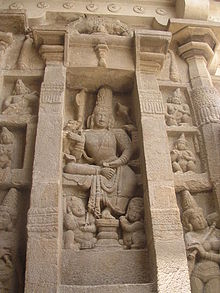Pal·lava





La dinastia Pal·lava (tàmil பல்லவர், anglès Pallava) fou una dinastia dràvida i hindú que va governar al sud de l'Índia entre el final del segle iii, quan va desplaçar als Kalabhra de la zona, i el segle ix.
La capital Pal·lava era Kanchipuram. A l'apogeu de llur poder, el regne dels pal·laves s'estenia sobre una gran part de l'Ìndia del Sud. Limitava al nord amb el regne Txalukia, amb el regne Txera a l'oest i amb el regne Txola al sud.
Història
[modifica]El període dels Pal·lava és un temps de grans canvis espirituals a l'Ìndia del Sud, el budisme va declinar, mentre el jainisme es va continuar desenvolupant i el moviment bhakti hindú va aparèixer. Els místics Alvar (vaixnavita) i Nayanmar (xaivita) varen donar vigor al moviment bhakti.
Els Pal·lava varen estar contínuament ocupats en guerres contra els txalukies de Badami. Al final llur regne fou eclipsat pels Txola en el segle viii.
Desenvolupament cultural
[modifica]Sota els Pal·lava va prosperar el commerç marítim amb l'Àsia del Sud-est. L'alfabet pal·lava[1] fou la base de nombrosos sistemes d'escriptura de l'Àsia del Sud-est, com l'alfabet birmà, el javanès, tailandès i khmer.
El regne Pal·lava Fou també un temps favorable per les arts. La música, pintura, literatura i arquitectura es varen desenvolupar. Els temples de pedra varen substituir als temples excavats, com hom pot observar a Mahabalipuram.
Reis Pal·lava
[modifica]Abans del 575 les dates són incertes.
- Bappadeva (v. 225 - 250)
- Visnugopa (v. 350-v. 355)
- Kumaravishnu I (v. 355-v. 370)
- Skandavarman II (v. 370-v. 385)
- Viravarman (v. 385-v. 400)
- Skandavarman III (v. 400-v. 438)
- Simhavarman II (v. 438-v. 460)
- Skandavarman IV (v. 460-v. 480)
- Nandivarman I (v. 480-v. 500)
- Kumaravishnu II (v. 500-v. 520)
- Buddhavarman (v. 520-v. 540)
- Kumaravishnu III (v. 540-v. 550)
- Simhavarman III (v. 550-v. 574)
- Simhavishnu (575-615)
- Mahendravarman I (615-630)
- Narasimhavarman I (630-668)
- Mahendravarman II (668-670)
- Parameshvaravarman I (670-690)
- Narasimhvarman II (690-715)
- Parameshvaravarman II (715-717)
- Nandivarman II (717-760)
- Dantivarman (760-812)
- Nandivarman III (812-844)
- Nripatungavarman (844-870)
- Aparajîta (870-888)
Referències
[modifica]Bibliografia
[modifica]- Avari, Burjor. India: The Ancient Past. New York: Routledge, 2007.
- Dubreuil, G. Jouveau; Dikshitar, V. S. Swaminadha. The Pallavas. India: Asian Educational Services, 1995. ISBN 8120605748.
- Hermann, Kulke; Rothermund D [2000]. A History of India. Routledge, 2001. ISBN 0-415-32920-5.
- Minakshi, Cadambi. Administration and Social Life Under the Pallavas. Madras: University of Madras, 1938.
- Nilakanta Sastri, K.A [1955]. A History of South India. New Delhi: OUP, 2002.
- Prasad, Durga. History of the Andhras up to 1565 A.D.. Guntur, India: P.G. Publishers, 1988.
- «South Indian Inscriptions». Archaeological Survey of India. What Is India Publishers (P) Ltd. [Consulta: 30 maig 2008].
- Enric Heras i Sicart, Studies in Pallava History, Madras, 1933.
Vegeu també
[modifica]Text is available under the CC BY-SA 4.0 license; additional terms may apply.
Images, videos and audio are available under their respective licenses.
